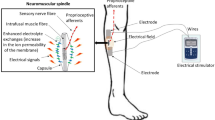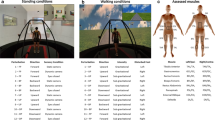Abstract
Introduction
Mal de Debarquement Syndrome (MdDS) is the rare condition of enduring rocking sensations and subjective unsteadiness following a lengthy exposure to passive motion. The pathogenesis of MdDS is unknown and the available treatment is limited. Here, we developed an experimental model of MdDS that may facilitate systematic inquiry of MdDS pathophysiology and the development of prevention or treatment strategies for this condition.
Methods
In an initial series of pilot experiments, suitable stimulation devices and conditions were evaluated. The final paradigm consisted of a low-frequency oscillatory motion stimulation, simultaneously deployed as roll and pitch rotation as well as heave on a six-degrees-of-freedom motion platform. Twelve healthy participants were stimulated under this condition for 30 min during free stance. Aftereffects with respect to rocking sensations and posturographic sway were monitored up to 60 min post-stimulation and compared to an initial pre-stimulation assessment as well as to posturographic recordings of spontaneous sway in ten patients with MdDS.
Results
Motion stimulation consistently evoked MdDS-like rocking sensations and postural alterations that lasted up to 45 min after cessation of passive motion exposure. Body sway alterations were most pronounced in anterior–posterior dimension during standing with eyes closed and primarily characterized by a distinct peak in the low-frequency sway spectrum close to stimulation frequency. These postural aftereffects further closely resembled spontaneous oscillatory low-frequency sway observed in patients with MdDS.
Conclusion
Subsequent neurophysiological and imaging examinations are required to investigate whether the model of transient, experimental MdDS actually shares a common substrate with the enduring pathological condition of MdDS.



Similar content being viewed by others
References
Brown JJ, Baloh RW (1987) Persistent mal de debarquement syndrome: a motion-induced subjective disorder of balance. Am J Otolaryngol 8:219–222
Cha Y-H, Brodsky J, Ishiyama G, Sabatti C, Baloh RW (2008) Clinical features and associated syndromes of mal de debarquement. J Neurol 255:1038–1044
Cha YH, Cui Y (2013) Rocking dizziness and headache: a two-way street. Cephalalgia 33:1160–1169
Cha YH, Cui YY, Baloh RW (2018) Comprehensive clinical profile of mal de debarquement syndrome. Front Neurol 9:261
Cha YH, Deblieck C, Wu AD (2016) Double-blind sham-controlled crossover trial of repetitive transcranial magnetic stimulation for mal de debarquement syndrome. Otol Neurotol 37:805–812
Clark BC, LePorte A, Clark S, Hoffman RL, Quick A, Wilson TE, Thomas JS (2013) Effects of persistent mal de debarquement syndrome on balance, psychological traits, and motor cortex exctiability. J Clin Neurosci 20:446–450
Cohen B, Yakushin SB, Cho C (2018) Hypothesis: the vestibular and cerebellar basis of the mal de debarquement syndrome. Front Neurol 9:28
Dai M, Cohen B, Cho C, Shin S, Yakushin SB (2017) Treatment of the mal de debarquement syndrome: a 1-year follow-up. Front Neurol 8:175
Dai M, Cohen B, Smouha E, Cho C (2014) Readaptation of the vestibulo-ocular reflex relieves the mal de debarquement syndrome. Front Neurol 5:124
Darwin E (1796) Why after voyage ideas of vibratory motions are perceived on shore. In: Zoonomia: The Laws of Organic Life. Vol. 1. London
Gordon CR, Spitzer O, Shupak A, Doweck I (1992) Survey of mal de debarquement. BMJ 304:544
Hain TC, Cherchi M (2016) Mal de debarquement syndrome. Handb Clin Neurol 137:391–395
Hain TC, Hanna PA, Rheinberger MA (1999) Mal de debarquement. Arch Otolaryngol Head Neck Surg 125:615–620
Huppert D, Oldelehr H, Krammling B, Benson J, Brandt T (2016) What the ancient Greeks and Romans knew (and did not know) about seasickness. Neurology 86:560–565
Krafczyk S, Schlamp V, Dieterich M, Haberhauer P, Brandt T (1999) Increased body sway at 3.5-8 Hz in patients with phobic postural vertigo. Neurosci Lett 259:149–152
Krafczyk S, Tietze S, Swoboda W, Valkovic P, Brandt T (2006) Artificial neural network: a new diagnostic posturographic tool for disorders of stance. Clin Neurophysiol 117:1692–1698
Mucci V, Cha YH, Wuyts FL, Van Ombergen A (2018) Perspective: stepping stones to unraveling the pathophysiology of mal de debarquement syndrome with neuroimaging. Front Neurol 9:42
Mucci V, Perkisas T, Jillings SD, Van Rompaey V, Van Ombergen A, Fransen E, Vereeck L, Wuyts FL, Van de Heyning PH, Browne CJ (2018) Sham-controlled study of optokinetic stimuli as treatment for mal de debarquement syndrome. Front Neurol 9:887
Nachum Z, Shupak A, Letichevsky V, Ben-David J, Tal D, Tamir A, Talmon Y, Gordon CR, Luntz M (2004) Mal de debarquement and posture: reduced reliance on vestibular and visual cues. Laryngoscope 114:581–586
Van Ombergen A, Van Rompaey V, Maes LK, Van de Heyning PH, Wuyts FL (2016) Mal de debarquement syndrome: a systematic review. J Neurol 263:843–854
Wawrzyński W, Krata P (2016) On ship roll resonance frequency. Ocean Eng 126:92–114
Wuehr M, Brandt T, Schniepp R (2017) Distracting attention in phobic postural vertigo normalizes leg muscle activity and balance. Neurology 88:284–288
Acknowledgment
The work was supported by the German Federal Ministry for Education and Science (BMBF, IFB 01EO1401).
Author information
Authors and Affiliations
Corresponding author
Ethics declarations
Conflicts of interest
The authors declare that they have no conflict of interest.
Additional information
This manuscript is part of a supplement sponsored by the German Federal Ministry of Education and Research within the funding initiative for integrated research and treatment centers.
Rights and permissions
About this article
Cite this article
Schepermann, A., Bardins, S., Penkava, J. et al. Approach to an experimental model of Mal de Debarquement Syndrome. J Neurol 266 (Suppl 1), 74–79 (2019). https://doi.org/10.1007/s00415-019-09345-6
Received:
Revised:
Accepted:
Published:
Issue Date:
DOI: https://doi.org/10.1007/s00415-019-09345-6




